Let’s start off with the first question many new SEO beginners want to know, what is Search Engine Optimization Guide for Beginners (aka SEO)?
SEO, or search engine optimization, is a way to get traffic to your website or page through search engines such as Google, Microsoft Bing, and others. The way to get those much coveted traffic is through improving a site’s rankings in the organic (non-paid) section of the search results. This is because the more visible your site is in the search results (the higher your rankings is), the more likely it is that your site will be found and will be clicked on by searchers. The goal of SEO is to get searchers to click on your site, and ultimately get them to convert into a customer, subscriber, etc.
There are a lot of factors that come into play when it comes to how search engines rank a site. In fact, they say that there are over 200 factors that Google considers when it comes to ranking a site. There are top factors, however, that serves as the foundation and that SEOs mainly focus on when optimizing and getting a page ranked. These are the content of the site/page, the use of specific keywords that are being targeted, and backlinks.
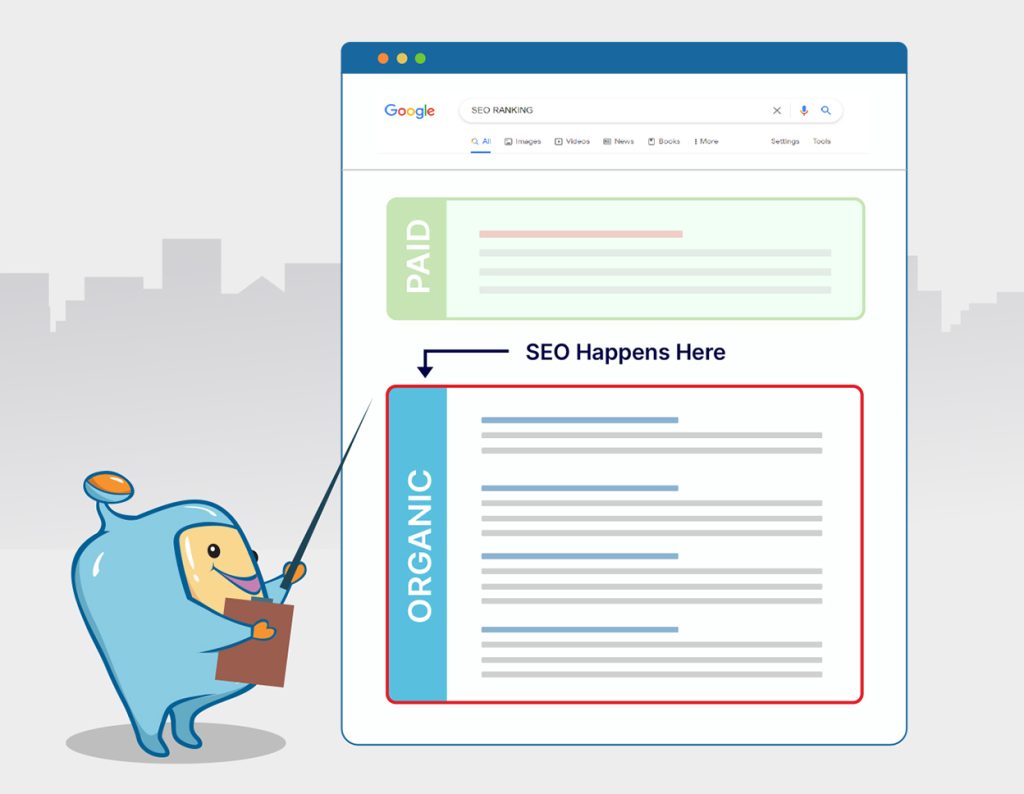
Keywords are the most important SEO ranking factor.
When you rank for a keyword, your site is the one that appears at the top of the list when a user searches for it.
Having a ranking keyword gives you free organic traffic every month.
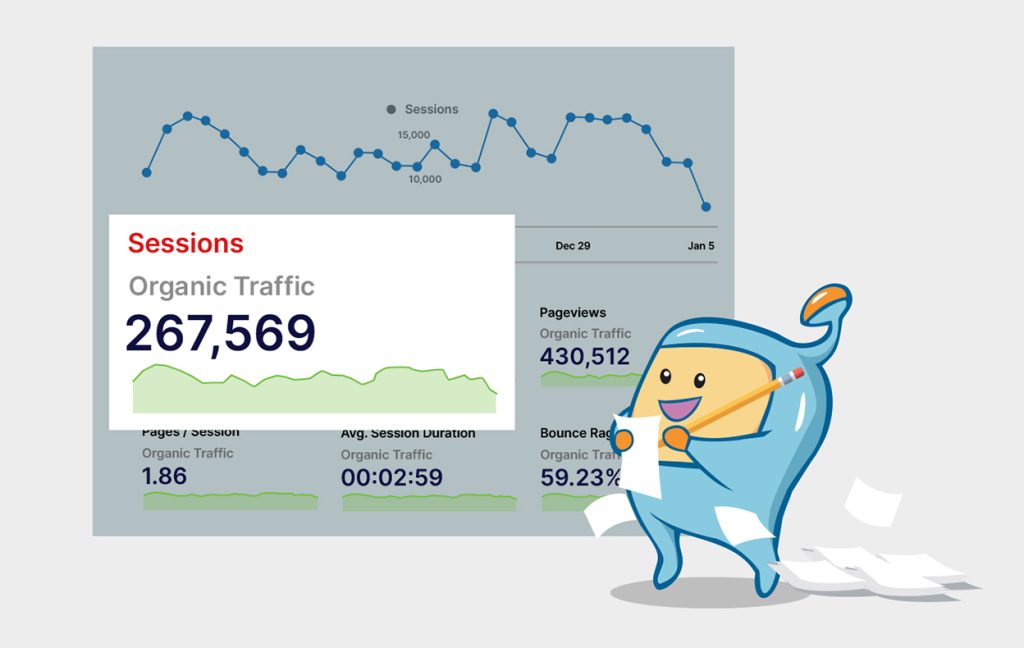
Here is what you will learn in this complete SEO guide for beginners:
SEO can be your main source of traffic. This is especially important for small businesses and entrepreneurs that have a small marketing budget.
Here is a traffic graph that breaks down where most traffic comes from:
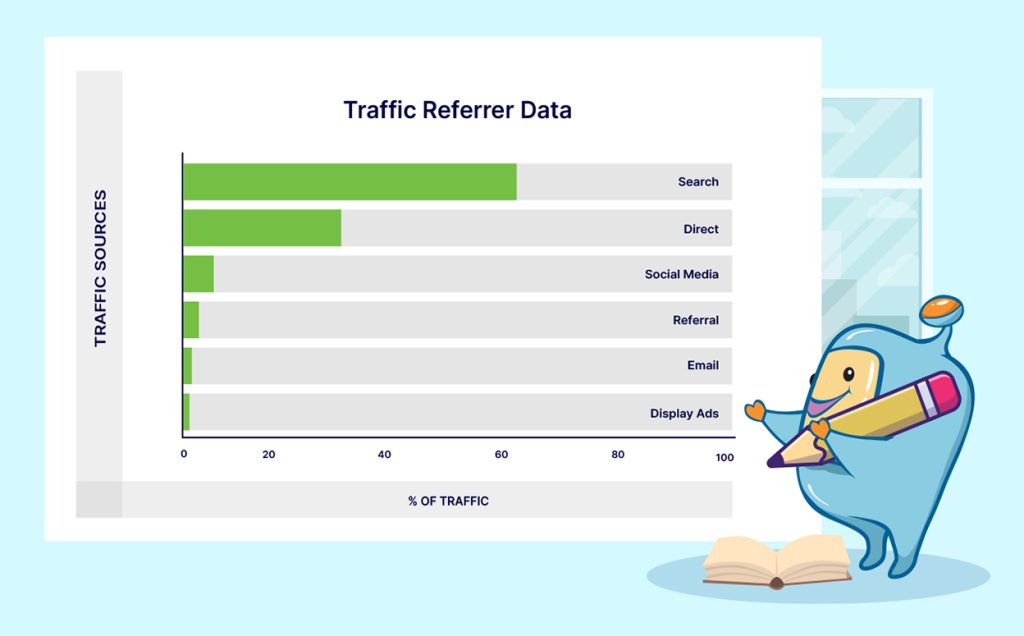
Search engines like Google, Yahoo, Bing and YouTube account for over 60% of traffic coming to a site. Search engine traffic is 10x more than those from social media traffic.
Here’s an example of how important SEO is:
Let’s say you have a puppy training business. Google Keyword Planner tells us that 40,000 people search for puppy training each month.
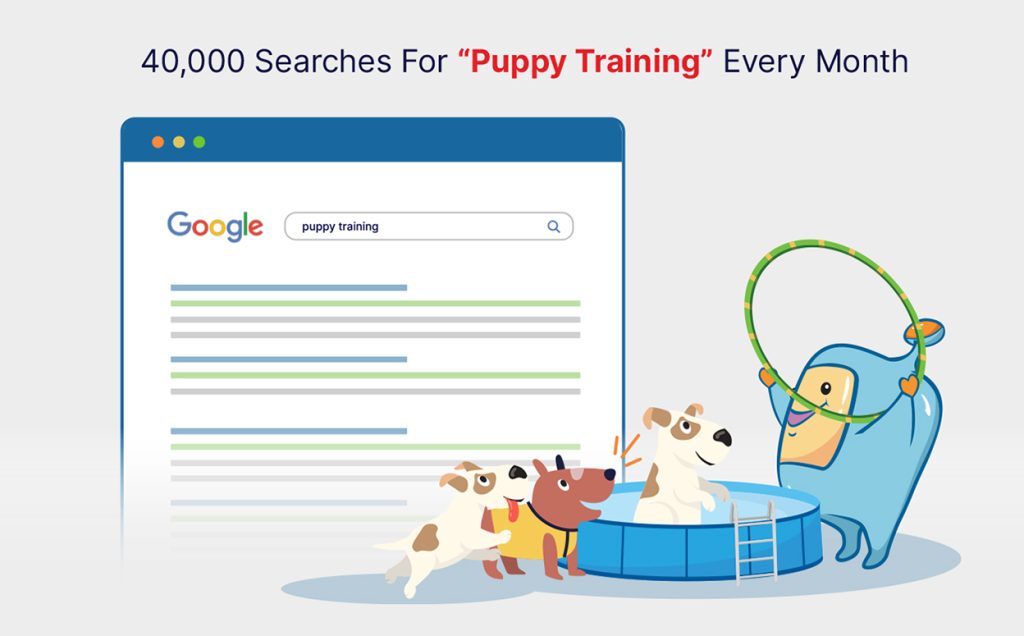
The first result in Google usually gets about 20% of the clicks. That would be 8,000 visitors to your website each month.
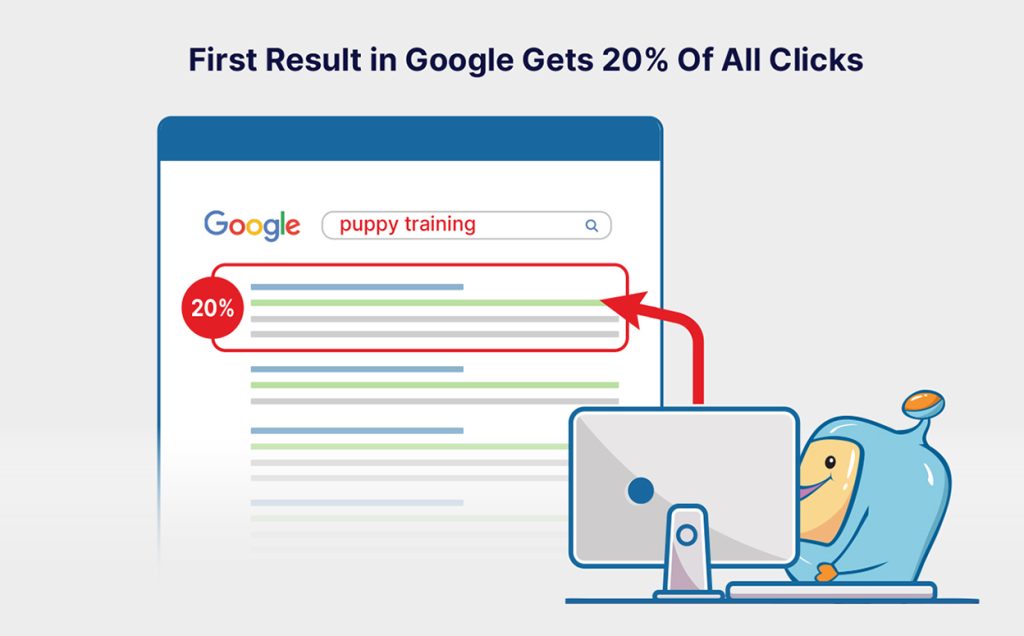
Click numbers are great, but how much are those visitors to your site worth?
The average person running ads for that keyword spends about $3.00 per click. With 8,000 visitors to your site, they are worth around $24,000 a month.
Could $24,000 a month help you in your business and your personal life?
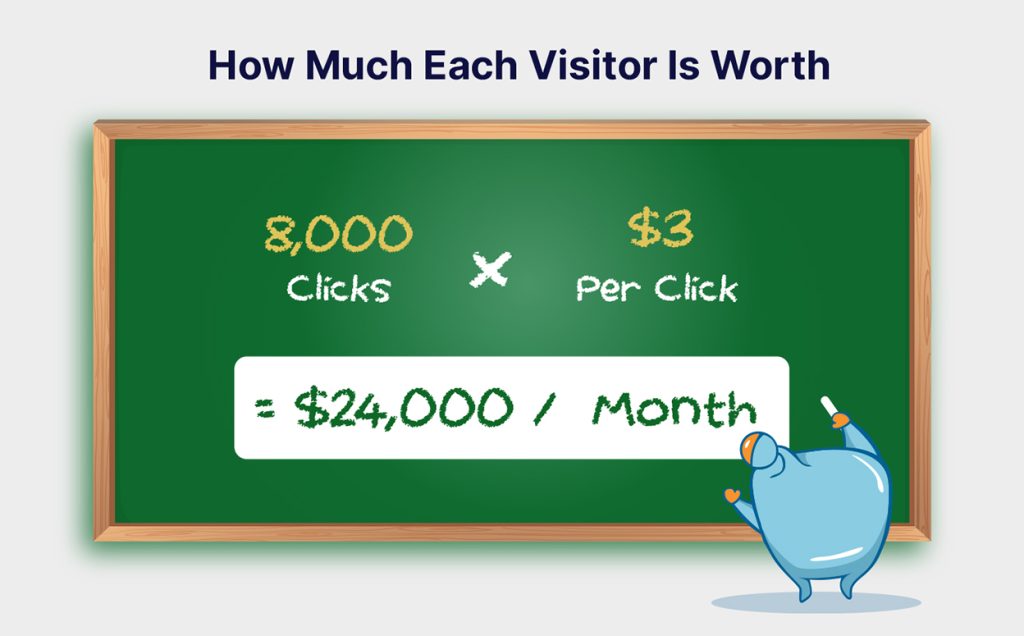
This is just for ONE keyword. When you have a great SEO strategy, you can rank for hundreds and even thousands of keywords.
Note: This guide is not a black hat SEO guide. Black hat SEO refers to a set of practices that are used to increase a site or page’s rank in search engines through means that violate search engines’ terms of service.
Google’s Search Central puts out its own SEO guide. Some of the information is good but some of it is not.
Many SEO experts parrot the information in Google’s guide without testing what truly works and what doesn’t. Useful tutorials and a good marketing strategy are based on testing the search engine algorithms.
That’s why this guide is so important. You’ll learn useful, applicable information that has been Google algorithm tested.
SEO works by using some known ranking factors in specific areas of your page. It is important that you make sure your site has these factors so search engines like Google, YouTube, Yahoo, Bing, and Amazon favor you.
Each search engine has an algorithm that scores your site. When you properly use known ranking factors, the algorithm will score you higher.
It’s been said that Google has over 200 ranking factors. In John Mueller’s video on September 24, 2021, he said Google was going to stop talking about their 200 ranking signals.
Since the SIA continues to test ranking factors, it doesn’t matter that Google is no longer talking about its ranking factors. We know what ranks. And we will continue to report it to our members.
When people talk about “SEO,” they usually mean Google SEO. This is why we’re going to focus on solid Google SEO strategy for this article.
The good news is that Google is not as sophisticated as many think it is. Let’s walk through how search engines work.
When you type something into the search in Google, you’ll be presented with the results that Google considers the best.
Image
Google looks at hundreds of billions of web pages in its index to find the best ones to match your search.
How does Google know which pages are the best?
While Google keeps how their algorithm works a secret, many marketers have broken down their algorithm based on patents. The SIA then takes statements Google makes and tests to see what is really a ranking factor.
From the patents and testing, we know that sites are ranked based on the following:
Authority
SEO Authority means Google sees your content as trustworthy and accurate.
But how does Google determine trustworthiness?
They are looking at backlinks to your page.
image
Backlinks are other sites linking to your page.
The more backlinks you have, the more authority Google sees you have (since people are linking to you). Google search will then reward you with a higher rank.
Relevancy
Google search looks for web pages that are most relevant to your search.
For example, if you search for “puppy training collar”, you don’t want to see the search return sites about college dorm decorating.
image
The best results are pages that are closely related to your keyword search.
When relevancy combines with authority and usefulness, you know how Google is deciding which page is the best result.
Usefulness
Usefulness is measured by user experience signals. User experience signals measure how users interact with each page. If a lot of people interact with a certain result, it will be boosted by Google.
Image positive user experience = boost in rankings
You can have high-quality content but it’s not deemed useful by Google. Google has stated that there is a difference between useful content and high-quality content.
image
Ryan Moulton, a software engineer at Google had this to say:
“MDN might be higher quality, better information, but that doesn’t necessarily mean it’s more useful to everyone.”
This quote is in reference to why W3schools is ranked so high, despite the content not being all that accurate.
He said, while MDN might be much more accurate, it is often way too over the top for most newbies to understand and thus not as useful.
For example, you search pinched nerve ibuprofen.
The first result is medicalnewstoday. This is written for the average person looking to get some pinched nerve relief at home.
It has 184 backlinks.
Image
Compare that to the result below it from the Mayo Clinic.
It has a lot of jargon and is more about explaining the pinched nerve rather than useful relief advice.
This result has 422 backlinks, yet, it ranked under medicalnewstoday.
Image
This page ranks lower on the usefulness scale, even though it has more backlinks.
Now let’s get into the good stuff.
When you look at search engine results, there are two different sections, paid and organic results.
Image
Organic Search Results (aka Natural Results)
Organic search results mean that you have not paid Google or any search engine to appear higher in the search results.
When you see sites that are organic, Google has chosen them based on ranking factors they deemed most important.
Image
You can see the paid search results by the ads that appear at the top or the bottom of the search results.
Image
While paid results show up with organic listings, advertisers are paying to have their page ranked in that spot. They pay per click (PPC). Each time someone clicks on the ad, the advertiser is paid a set fee, That fee will vary by keyword.
Do you know what your ideal customer wants when they type in your keyword? Before you even approach writing articles, you want to know the words and phrases your potential visitors are searching for.
Customer research starts at the persona level.
In the marketing world, you hear so much about the customer avatar (aka customer persona) that it can be nausea-inducing.
A customer persona is a pretend likeness of your customer. This persona will include who this person is as well as behaviors, beliefs, and industry insights they may have. Your customer persona will match your ideal customer.
Do you know who you’re exactly selling to?
If you answered something like: men, small business owners, fathers…
…then you’re missing out on traffic and sales.
It’s important when you are selling anything online to know who your target market is.
By having a clear picture of who you are talking to, you will know how to craft your content to meet their needs.
This will help you sell more products or services.
Here is an example of a customer avatar persona:
Image
To reach your customer, you need to know what topics your customer is typing into Google. What are your searchers interested in?
If you feel a little overwhelmed right now, we get it!
There are many different articles that teach you how to build your customer persona from scratch. If you want to work smarter and not harder, the easiest way to build your customer persona is to use free tools.
If you are just starting out building your website, you can create your customer persona with an easy-to-go-through process. https://www.hubspot.com/make-my-persona
Price: Free
If you have an existing website and Google Analytics on your site, you can use the live persona feature of Delve. https://www.delve.ai/live-persona
Price: Free for one persona under the Free Lite Plan. Paid plans start at $89 USD per month.
You want to use specific keywords based on your customer persona.
What are the exact searches that your visitors are typing into the search engine?
image
There are two types of keywords that you want to focus on.
Product keywords – Product keywords are keywords that describe your product best. These are the keywords that someone will use when they are looking for a specific product or service.
Ecommerce sites usually are packed with product type keywords.
Here are a few examples:
Scuba Diving Fins
Gull Scuba Fin
Scuba diving in the Caribbean
Informational keywords – People type this is because they want information about a subject.
Free diving vs Scuba diving
What are the best fins for scuba diving?
How to pick the best scuba fins?
Ubersuggest and Quora are great tools to find informational search keywords because the topics and there are completely user-driven.
Answer the Public is also really good for question based informational words and phrases.
To get started, you don’t need expensive, fancy SEO tools. Any keyword tool will help you find good relevant keywords.
Whether you are just starting out and have a limited budget or you are a seasoned SEO, there is one tool every marketer should be using.
That is Google.
Google autocomplete is the easiest way to find keywords.
When you begin to type something into Google, you will be served a list of search suggestions.
Next you want to look for the People Also Ask section inside Google’s Search Engine Results Page or SERPs for short.
Finally, you’ll look at the Related Searches section all the way to the bottom of the search page.
Keep a list of all the keywords that you can design content around.
There’s keywords and then there’s easy and quick to rank for keywords. By using the Keyword Golden Ration (KGR) you can find quality, low competition keywords in your niche.
If you love data, this keyword method is for you. You’ll be finding the underserved keywords that most marketers are missing.
The keywords found using this method tends to rank high in Google within a few days.
The Formula: The number of Google results that have the keyword phrase in the page title divided by the monthly search volume, where the search volume is less than 250.
Steps:
1) Goto Google and do a search like this: allintitle:best kayaks for fishing
2) Note the number of results returned. It is used in the formula listed below.
3) Use Semrush, Ahrefs, KWFinder or similar tool to get the search volume for this keyword.
4) Calculate the ratio according to formula.
Finding KGR compliant keywords can be a bit time-consuming. It is best to create a spreadsheet and record the results for all the keywords you are researching.
Search intent is also known as user intent.
Search Intent is the reason why someone is searching on Google or other search engines. People have learned to use specific words to find what they are looking for. Search engines use machines to understand what people mean when they search.
When you are looking at search intent, you want to know the reason someone is looking up that keyword.
There are four important types of Search intent that all marketers should know:
Image
Informational – People type this is because they want information about a subject.
Navigational – These are typically found in the navigation of a website like contact, social media, or login page.
Commercial – People type these in when they are thinking of making a purchase. They may look up “best [insert keyword]”.
Transactional – These are keywords people type in when they know what they want and are ready to make a purchase.
It is important that you understand your user search intent so you can serve them the right piece of content.
Let’s say you are hungry and want some pizza.
You’ll type in Chicago Pizza Near Me.
Tip: You don’t want to search for NY pizza because Chicago has the best type of pizza.
This search query is transactional because you are ready to buy your pizza.
Let’s say you want to make Chicago pizza at home. You’ll search for Chicago Pizza Sauce Recipe.
(The sauce and crust are everything when it comes to pizza!)
This is an informational search because you want to know how to make it.
The better your content serves these types of queries, the higher you’ll rank.
The easiest way to find your user intent is to type in your keywords.
Look at the first page results.
What is Google telling you about your user intent?
Is Google really smart enough to know if a page is a good match to user intent?
Yes and no. Google is paying attention to how people interact with search results.
If several people skipped over certain pages but clicked on others, Google analyzed those to figure out user intent of certain keywords.
Google notices when people click on a result but then bounce back to the search engine to search more. Google will begin to see that content as not being a good match for the search intent.
If you are using a search term that is low volume, you may see mixed results.
The most important aspect is to make sure you have relevant content. Focus on creating new content that matches the user intent for your user persona and keyword.
You only have two sentences to either peak someone’s interest or lose them. Make sure you craft a great intro that tells your reader what they will discover.
Add good images and graphics. Images help break up big walls of text and is visually engaging.
Link your articles. This will help your site be a one-stop place for your readers. Internal links help keep people on your site and external links help give your reader more relevant information. Most of all, it helps to prevent people from bouncing back to the search to look more.
Make sure your technical SEO is up to par. Run your site through Screaming Frog and fix as many technical issues or html and coding issues as you can.
Connect Google Analytics to your site. Check Google Search console for any errors that Google is reporting.
Tip: If Google Search Console reports a server error, it means that Googlebot couldn’t access your URL, the request timed out, or your site was busy. Fix these errors immediately.
You especially want to make sure your pages are fast-loading and your site has great usability. Visitors typically don’t like to run into broken links.
Slow loading sites and broken links will increase your bounce rate.
Now that you know your user intent and have your list of keywords, it’s time to create SEO friendly content.
Say your child has lice (Ewww, I know) and you want to know how to get rid of them before you begin to imagine an itchy head.
Would you rather read a poorly written article?
Or would you rather read a well-researched article that tells you how to quickly solve your problem?
Can poorly written content rank? Absolutely.
Will it usually have a high bounce rate? Yes.
Can it cause people to lose confidence in a brand or business? Absolutely.
Poorly written content is generally internet marketers, digital marketers, and SEOs testing the SERPs and refining their metrics.
This doesn’t mean that you have to have blog post style product or service pages. Focus on the elements that can answer your reader’s questions.
What are the benefits and features of your product or service?
Tip: Benefits and features is especially important for local SEO when your competition may be fierce.
You definitely want to invest either the time or money into have good quality content written.
Prioritize your content. Not only will great content help your sales, it may also increase the valuation of your company down the road.
High quality content is useful information that your readers will find valuable. And hopefully share on social media.
Blog creators that go on to sell their websites for millions of dollars put out great content that searchers find useful.
If you have a blog, it helps to consistently post content. Create a publishing schedule and stick to it!
Popular content are:
Step by step Guides – Focus on key details and go in depth as you take your reader on a step by step guide.
Complete Guides – This will be an indepth article helping people to understand every possible aspect of a topic.
Complete Lists – This is a list of tips, tricks, items, techniques or strategies.
Research and Data-based Content – People trust authoritative research and like to see references.
Infographics – People love visual graphics like infographics. Not only does this give people the data they love, but they also love linking to and sharing visual graphics.
Don’t have a one hit wonder keyword that is the only one to rank high in the major search engines.
Stay in the awareness of people. Get your content and pages in front of your customers.
Have the goal of taking over the SERPs and showing up everywhere your user persona would be looking.
Google has an ideal that they want to see for each keyword. And this is different for every keyword.
On-page SEO is making sure Google can find your web pages so they can show them in the search results. It also involves having relevant, detailed, and useful content to the search phrases you’re trying to show up for.
Specifically, Google scans your page for specific words and phrases.
And when it sees the same term over and over again, Google says: “This page must be about this keyword!”.
That’s why it’s important to use your target keyword on your page… without going overboard.
For now, let’s cover how to optimize your site’s on-page SEO.
The #1 rule of on-page SEO is this:
Use your keyword in your title meta tags.
Why is this important?
Well, when it comes to on-page optimization, your title tag is the most important part of your page.
Think about it this way:
Your title tag summarizes what your page is all about. And when you use your keyword in your title tag, it tells Google that your page is about that keyword.
Your meta description isn’t nearly as important as your title tag.
In fact, Google has said that they don’t pay much attention to your description (or meta keywords).
So why should you bother creating a description?
Because people use your description to figure out whether or not to click on your result.
See how I really sell my content? That enticing description “steals” clicks from the sites ranking above me. Which (obviously) brings in more traffic to my site.
Pro Tip: Use your main keyword in your description. When someone searches for that term, Google will bold your keyword… which helps your site stand out even more in the SERPs.
Next, you want to include your keyword on your page a few times.
That way, Google will be confident that your page is really about that topic.
Include that keyword in the first 150 words. And also throughout the content
Make sure to use synonyms and variations of your target keyword throughout your content.
This can help your single page for dozens of different keywords. (LSI keywords are basically terms that are closely related to my main keyword.)
How about another example?
Let’s say you just published an article that’s optimized around the keyword: “digital marketing tips”.
Well, you’d want to use variations of that term in your content like:
Pro Tip: Find find variations of your keyword in Google and Bing Suggest. Just type your keyword into the search bar and check out the suggestions.
See any that make sense for your content? Use ‘em!
Unlike a text-based article, search engines have a hard time understanding what’s inside of an image.
So they rely on your image’s filename, alt text and title to figure out what an image actually is.
And if you run a site with lots of images, image SEO is SUPER important. Otherwise, Google will have a hard time understanding what’s on your page.
With that, here’s how to optimize your images:
First, give your image a descriptive filename. For example, check out this screenshot of the number of comments one of our guides got.
We used the filename: mobile-seo-guide-comments.png.
Simple.
Next, use an image alt text that describes your image.
Finally, give your image a title. I wouldn’t sweat this step as much. I just copy and paste my alt text here.
You can have a webpage that’s optimized PERFECTLY for SEO.
It’s not going to rank for very long.
Even though User Experience is subjective (which makes it hard for major search engines like Google, Bing, and Yahoo to measure), it does indirectly impact your SEO.
After all, if your site is hard to use, people aren’t going to share it. And without links and shares, your chances of ranking in Google are pretty much zero.